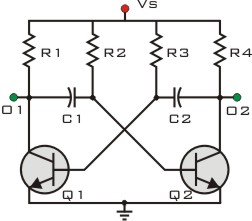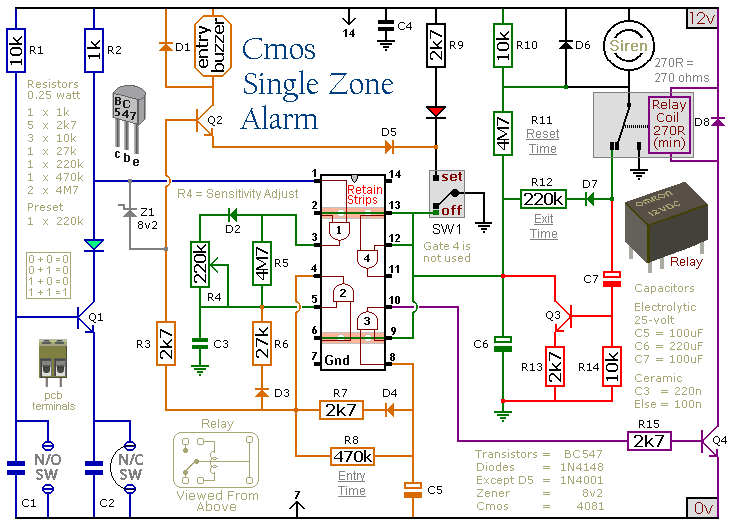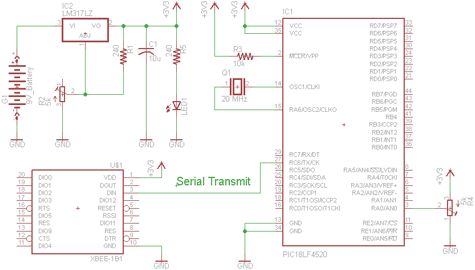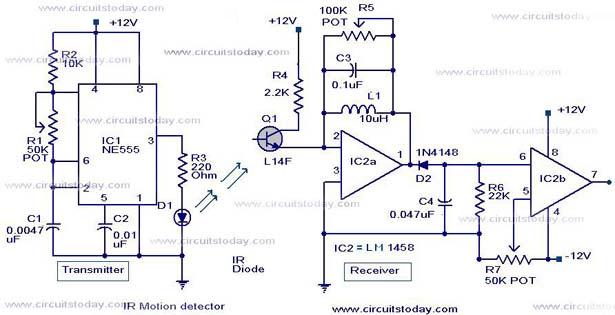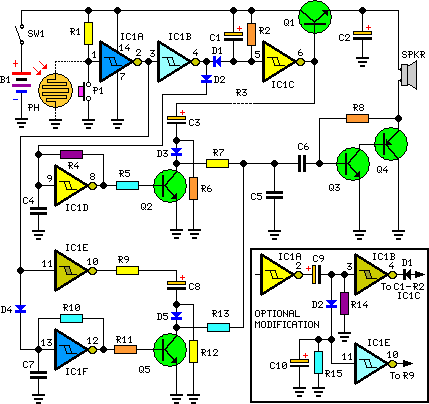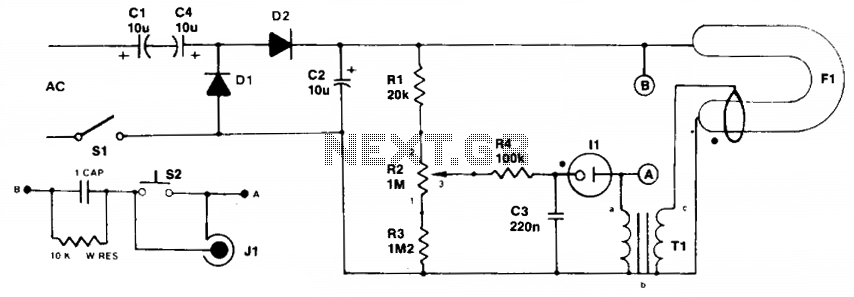
preamp circuit
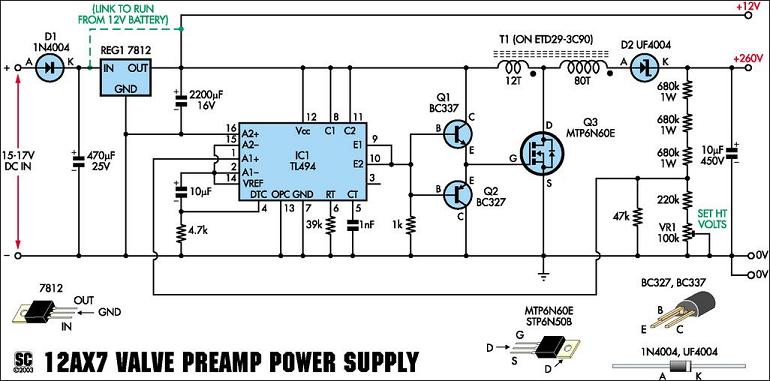
Using a K-12 tube amplifier with a NAD C542 CD player eliminates the necessity for a buffer or line-level preamplifier. The K-12 amplifier is characterized by its polite and sweet sound, embodying the warmth typical of its "hot bottle" heritage. However, in comparison to monoblock chip amplifiers (LM3875), there was a lack of convincing emotional delivery from the chip amps, which the K-12 effortlessly provided. To enhance the sound quality, a cost-effective Valve Preamp kit from Silicon Chip Online was utilized. This preamp kit features a common 12AX7 dual triode with a line-level (Hi-Fi) gain set at 4 (6 dB). The affordability of this kit is attributed to its power source, which is a switch-mode power supply powered by a 17-volt DC wall wart. A stock build of the kit is depicted in Photograph 01. The schematic of the preamplifier section is illustrated in Figure 01 (© Silicon Chip Online, with permission for hosting). Additionally, the schematic of the switch-mode power supply section is shown in Figure 02 (© Silicon Chip Online, with permission for hosting). Before assembling the preamplifier kits, quality Sprague capacitors were acquired to enhance the signal path capacitors. Photograph 02 depicts the completed power supply and preamp module with the upgraded capacitors. After assembling the boards, snubber circuits were added to both the preamp and power supply sections, as shown in Photograph 03, which illustrates the snubbers added to the underside of the PCBs.
The K-12 tube amplifier is a Class A amplifier known for its rich, warm sound, making it particularly suitable for audio applications where tonal warmth is desired. The NAD C542 CD player serves as a high-quality source component, providing a digital-to-analog conversion that complements the analog characteristics of the K-12 amplifier. The decision to forego a buffer or line-level preamplifier stems from the K-12's inherent ability to drive speakers effectively without additional gain or buffering, which can sometimes introduce unwanted coloration or distortion.
The Valve Preamp kit, based on the 12AX7 dual triode, is designed to amplify the audio signal while preserving the tonal characteristics that tube amplifiers are known for. With a gain of 6 dB, this preamp is ideal for applications where a modest increase in signal level is needed without overwhelming the subsequent stages of amplification. The use of a switch-mode power supply is particularly advantageous as it provides a compact and efficient means of powering the preamp while minimizing noise and interference that can affect audio quality.
The enhancement of the signal path capacitors with higher-quality Sprague capacitors is a common practice in audio engineering, as it can significantly improve transient response and overall sound clarity. The addition of snubber circuits to both the preamp and power supply sections serves to mitigate high-frequency noise and improve stability, further refining the audio output.
This comprehensive setup, combining the K-12 amplifier, NAD C542 CD player, and the upgraded Valve Preamp kit, exemplifies a thoughtful approach to achieving high-fidelity sound reproduction, with careful attention paid to component selection and circuit design.Using a K-12 tube amp with a NAD C542 CD player, there is no need for a buffer or line level preamplifier. The K-12 is a very polite and sweet amp with all the warmth of it`s "hot bottle" heritage. However, when I compare the K-12 with my monoblock chip amps (LM3875), I was never convinced that the chips amps really delivered the passion of the m
usic which the K-12 does so easily. There was always something missing when it came to a convincing delivery. I felt a little of that beautiful valve warmth was required, so I tried a very affordable Valve Preamp kit from Silicon Chip Online. The preamp kit is based around a common 12AX7 dual triode. The line level (Hi-Fi) version of the kit has the gain set at 4 (6 dB). What makes this kit very inexpensive is that power comes a switch mode power supply, fed from a 17 volt DC wall wart!
Photograph 01 shows a stock build of the kit. The schematic of the preamplifier section is shown in Figure 01. (Please note that this circuit is © Silicon Chip Online and permission to host the schematic on this site has been provided by Silicon Chip Online. The schematic of the switch mode power supply section is shown below in Figure 02. (Please note that this circuit is © Silicon Chip Online and permission to host the schematic on this site has been provided by Silicon Chip Online.
Prior to building the preamplifier kits, I purchased some nice Sprague capacitors in order to upgrade the signal path capacitors. Photograph 02 shows the completed power supply and preamp module with the upgraded capacitors. Once I had put together the boards, I proceeded to add snubbers to the preamp and power supply sections.
Photograph 03 shows the snubbers added to the underside of the PCBs. 🔗 External reference
The K-12 tube amplifier is a Class A amplifier known for its rich, warm sound, making it particularly suitable for audio applications where tonal warmth is desired. The NAD C542 CD player serves as a high-quality source component, providing a digital-to-analog conversion that complements the analog characteristics of the K-12 amplifier. The decision to forego a buffer or line-level preamplifier stems from the K-12's inherent ability to drive speakers effectively without additional gain or buffering, which can sometimes introduce unwanted coloration or distortion.
The Valve Preamp kit, based on the 12AX7 dual triode, is designed to amplify the audio signal while preserving the tonal characteristics that tube amplifiers are known for. With a gain of 6 dB, this preamp is ideal for applications where a modest increase in signal level is needed without overwhelming the subsequent stages of amplification. The use of a switch-mode power supply is particularly advantageous as it provides a compact and efficient means of powering the preamp while minimizing noise and interference that can affect audio quality.
The enhancement of the signal path capacitors with higher-quality Sprague capacitors is a common practice in audio engineering, as it can significantly improve transient response and overall sound clarity. The addition of snubber circuits to both the preamp and power supply sections serves to mitigate high-frequency noise and improve stability, further refining the audio output.
This comprehensive setup, combining the K-12 amplifier, NAD C542 CD player, and the upgraded Valve Preamp kit, exemplifies a thoughtful approach to achieving high-fidelity sound reproduction, with careful attention paid to component selection and circuit design.Using a K-12 tube amp with a NAD C542 CD player, there is no need for a buffer or line level preamplifier. The K-12 is a very polite and sweet amp with all the warmth of it`s "hot bottle" heritage. However, when I compare the K-12 with my monoblock chip amps (LM3875), I was never convinced that the chips amps really delivered the passion of the m
usic which the K-12 does so easily. There was always something missing when it came to a convincing delivery. I felt a little of that beautiful valve warmth was required, so I tried a very affordable Valve Preamp kit from Silicon Chip Online. The preamp kit is based around a common 12AX7 dual triode. The line level (Hi-Fi) version of the kit has the gain set at 4 (6 dB). What makes this kit very inexpensive is that power comes a switch mode power supply, fed from a 17 volt DC wall wart!
Photograph 01 shows a stock build of the kit. The schematic of the preamplifier section is shown in Figure 01. (Please note that this circuit is © Silicon Chip Online and permission to host the schematic on this site has been provided by Silicon Chip Online. The schematic of the switch mode power supply section is shown below in Figure 02. (Please note that this circuit is © Silicon Chip Online and permission to host the schematic on this site has been provided by Silicon Chip Online.
Prior to building the preamplifier kits, I purchased some nice Sprague capacitors in order to upgrade the signal path capacitors. Photograph 02 shows the completed power supply and preamp module with the upgraded capacitors. Once I had put together the boards, I proceeded to add snubbers to the preamp and power supply sections.
Photograph 03 shows the snubbers added to the underside of the PCBs. 🔗 External reference
